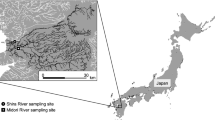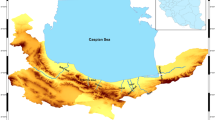Abstract
Multiple parameters may affect the fate of metals between solid and liquid phases in estuarine zones. The present investigation brings out the roles of salinity and dissolved oxygen (DO) in flocculation of colloidal metals and their subsequent remobilization during estuarine mixing. For this purpose, a series of aquaria containing river water with different salinity regimes under both natural and aerated conditions were set up. The same process was repeated in the second round of the experiments, while fine suspended sediments were added to the aquaria. Except for Cu and Zn, a remarkable increase in flocculation rate of metals was observed under aerated conditions (around 20% increase in DO value) in comparison with natural conditions. The flocculation pattern under natural conditions can be summarized as Zn (49.3%) > Cu (34.1%) > Ni (27.5%) > Mn (3.37%) > Pb (1.3%), while under aerated conditions, the pattern changes to Ni (62.5%) > Zn (53.4%) > Cu (34.1%) > Pb (20.7%) > Mn (18.7%). Most of flocculated metal contents were achieved in lower salinities (0.8 to 1.9 Psu). Mobility potential of all metals in sediments showed a decreasing trend at higher salinities from 5.9% for Zn to 30% for Pb. The reason behind the decreasing trend can be attributed to the lower metal concentrations reaching higher salinity regimes. In other words, much of metal contents floc at lower salinity regimes and very minute amount is left over for higher salinities. On the contrary, DO concentration has a remarkable effect on increasing the mobility potential of most of metals. The proportional increase order shows a decreasing pattern of Pb (80.1%) > Cu (54%) > Zn (23.3%) > Ni (14.1%). However, it should be noted that Mn due to its different affinity in fractionation schemes revealed relatively lower mobility under aerated conditions.





Similar content being viewed by others
Availability of data and materials
Data supporting the findings of this work are indicated within the paper. Detailed data, however, are available from the corresponding author upon request.
References
Aiken GR, Hsu-Kim H, Ryan JN (2011) Influence of dissolved organic matter on the environmental fate of metals, nanoparticles, and colloids. Environ Sci Technol 45:3196–3201
Bainbridge ZT, Wolanski E, Álvarez-Romero JG, Lewis SE, Brodie JE (2012) Fine sediment and nutrient dynamics related to particle size and floc formation in a Burdekin River flood plume. Aust Mar Pollut Bull 65(4–9):236–248
Bastami KD, Neyestani MR, Molamohyedin N, Shafeian E, Haghparast S, Shirzadi IA, Baniamam M (2018) Bioavailability, mobility, and origination of metals in sediments from Anzali Wetland, Caspian Sea. Mar Pollut Bull 136:22–32
Biati A, Karbassi AR (2012) Flocculation of metals during mixing of Siyahrud River water with Caspian Sea water. Environ Monit Assess 184(11):6903–6911
Biati A, Karbassi AR, Hassani AH, Monavari SM, Moattar F (2010) Role of metal species in flocculation rate during estuarine mixing. Int J Environ Sci Technol 7(2):327–336
Chester R, Hughes R (1967) A chemical technique for the separation of ferro-manganese minerals, carbonate minerals and adsorbed trace elements from pelagic sediments. Chem Geol 2:249–262
Fazelzadeh M, Karbassi AR, Mehrdadi N (2012) An investigation on the role of flocculation processes in geo-chemical and biological cycle of estuary (case study: Gorganrood River). Int J Environ Res 6(2):391–398
Huang L, Rad S, Xu L, Gui L, Song X, Li Y, Wu Z, Chen Z (2020) Heavy metals distribution, sources, and ecological risk assessment in Huixian Wetland. South Chin Water 12(2):431
Jain CK (2004) Metal fractionation study on bed sediments of River Yamuna. India Water Res 38(3):569–578
Jamshidi S, Bastami KD (2016) Metal contamination and its ecological risk assessment in the surface sediments of Anzali wetland Caspian Sea. Mar Pollut Bull 113(1–2):559–565
Jilbert T, Asmala E, Schröder C, Tiihonen R, Myllykangas JP, Virtasalo JJ, Kotilainen A, Peltola P, Ekholm P, Hietanen S (2017) Flocculation of dissolved organic matter controls the distribution of iron in boreal estuarine sediments. Biogeosci Discuss. https://doi.org/10.5194/bg-2017-181,2017
Karbassi AR, Marefat A (2017) The impact of increased oxygen conditions on heavy metal flocculation in the Sefidrud estuary. Mar Pollut Bull 121(1–2):168–175
Karbassi AR, Tajziehchi S, Adib NF (2016) Role of estuarine natural processes in removal of trace metals under emergency situations. Glob J Environ Sci Manag 2(1):31–38
Nasrabadi T, Ruegner H, Sirdari ZZ, Schwientek M, Grathwohl P (2016) Using total suspended solids (TSS) and turbidity as proxies for evaluation of metal transport in river water. Appl Geochem 68:1–9
Nasrabadi T, Ruegner H, Schwientek M, Bennett J, Fazel Valipour S, Grathwohl P (2018) Bulk metal concentrations versus total suspended solids in rivers: time-invariant & catchment-specific relationships. PLoS ONE 13(1):e0191314
Perin G, Craboledda L, Lucchese M, Cirillo R, Dotta L, Zanette ML, Orio AA (1985) Heavy metal speciation in the sediments of Northern Adriatic Sea – a new approach for environmental toxicity determination. In: Lakkas, T.D. (Ed.), Heavy Metal in the Environment. CEP Consultants, Edinburgh, pp. 454–456.
Qing X, Yutong Z, Shenggao L (2015) Assessment of heavy metal pollution and human health risk in urban soils of steel industrial city (Anshan), Liaoning, Northeast China. Ecotoxicol Environ Saf 120:377–385
Saffari M (2018) Chemical Stabilization of Some Heavy Metals in an Artificially Multi-Elements Contaminated Soil, Using Rice Husk Biochar and Coal Fly Ash. Pollution 4(4):547–562
Shamkhali Chenar S, Karbassi AR, Hajizadeh Zaker N, Ghazban F (2013) Electroflocculation of metals during estuarine mixing (Caspian Sea). J Coast Res 29(4):847–854
Sholkovitz ER (1976) Flocculation of dissolved organic and inorganic matter during the mixing river water and seawater. Geochim Cosmochim Acta 40(7):831–845
Valikhani Samani AR, Karbassi AR, Fakhraee M, Heidari M, Vaezi AR, Valikhani Z (2015) Effect of dissolved organic carbon and salinity on flocculation process of heavy metals during mixing of the Navrud River water with Caspian Sea water. Desalin Water Treat 55(4):926–934
Wigginton NS, Haus KL, Hochella MF (2007) Aquatic environmental nanoparticles. J Environ Monit 9(12):1306–1316
Zhiqing LE, Jianhu Z, Jinsi C (1987) Flocculation of dissolved Fe, Al, Si, Cu, Pb and Zn during estuarine mixing. Acta Oceanol Sin 6(4):567–576
Acknowledgements
Not applicable.
Funding
The authors declare that no funds, grants, or other support were received during the preparation of this manuscript.
Author information
Authors and Affiliations
Contributions
Conception and design of the work were made by TN, AES, AK, and MB. AES, AK, and MB collected and analyzed the samples. Data processing and statistical analysis were done by TN, AES, and AK.
Corresponding author
Ethics declarations
Conflict of interests
The authors declare that they have no known competing financial interests or personal relationships that could have appeared to influence the work reported in this paper.
Ethics approval
Not applicable.
Consent to participate
Not applicable.
Consent for publication
Not applicable.
Code availability
Not applicable.
Additional information
Publisher's Note
Springer Nature remains neutral with regard to jurisdictional claims in published maps and institutional affiliations.
Supplementary Information
Below is the link to the electronic supplementary material.
Rights and permissions
About this article
Cite this article
Nasrabadi, T., Soodarjani, A.E., Karbassi, A. et al. Role of salinity and aeration on flocculation and remobilization of metals during estuarine mixing. Environ Earth Sci 81, 277 (2022). https://doi.org/10.1007/s12665-022-10413-w
Received:
Accepted:
Published:
DOI: https://doi.org/10.1007/s12665-022-10413-w




